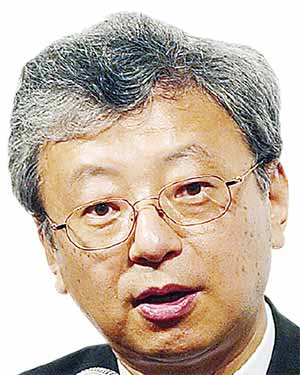11:00 JST, October 11, 2024
Let’s compare two economies with inflation rates of 2% and 0%. Which one is more vibrant? This is a topic that has been debated in the field of economics for a long time, as a question about what inflation rate is optimal for society.
If you think about these examples simply, there seems to be no significant difference between them. This is because the prices of all goods and services and wages increase by 2% across the board in an economy with an inflation rate of 2%, making it appear that the real economy is unaffected.
However, the actual state of an economy with 2% inflation and one with zero inflation differs greatly, with the higher inflation economy often being more active. The keyword for this phenomenon is “metabolism.”
When Japan had a deflationary economy for more than 20 years before the COVID-19 pandemic, near-zero inflation continued year after year. Over that period, prices and wages in Japan were either essentially unchanged or kept declining moderately.
This long phase of deflation was characterized by the fact that while prices and wages hardly changed at the macro level, there were also no micro-level actions by businesses to raise their prices and wages.
What was in the background was the downward rigidity of wages. Even if there is deflation, few companies will lower salaries. Companies may increase the ratio of non-regular workers to reduce labor costs, but it is hard for them to curtail the wages of regular employees. Few companies would raise wages, either, under deflationary pressure.
Therefore, throughout the period of deflation, most companies neither raised nor lowered their employees’ wages. Under such circumstances, things seemed to be stable — the unemployment rate was not so high and there were few corporate failures.
Nonetheless, this state is more accurately referred to as stagnant than stable. In this situation, many “zombie” companies survived — they could not even pay the interest on their debt with their own profits but managed to remain afloat by relying continuously on loans — and the rates of income and productivity growth remained at low levels.
2% inflation
What happens if macro-level inflation steadily increases to about 2%? Even then, quite a lot of companies are likely to refrain from raising wages because for those with poor performance, the obstacles to offering wage hikes are too high.
However, a number of other companies may start to raise wages by 4% or even more. When this is the case, a wage hike distribution map will show a clear disparity between companies that maintain zero growth in their wages and those that offer an increase of over 4%, with the macro-level rate standing at 2%.
Given the downward rigidity of wages, there are few companies that lower wages during deflation, but once wages increase across society, certain companies will choose a large increase in wages for their employees.
Then disparities arise among companies and industrial sectors. Such wage disparities prompt labor to move between companies and sectors, a development that is thought to help accelerate economic metabolism.
In a society that experiences significant labor transitions, there are many cases in which active job changes among workers contribute to increasing labor productivity. In contrast, companies that cannot improve performance and struggle to boost productivity are not capable of realizing large wage increases.
On the other hand, growing sectors need to offer higher wages to attract many human resources.
Job mobility from low-wage-increase sectors to those with more quickly growing wages means labor transitions from low-productivity sectors into high-productivity ones. As a result, labor transitions help raise productivity throughout an economy, giving momentum to the trend to weed out, through wage disparities, companies that don’t have a sustainable business model.
The ability to increase wages varies, depending on companies and sectors. When the economy faces a structural labor shortage due to a declining birth rate and an aging population, companies capable of raising wages will be able to survive while those unable to do so will have to go out of business. The labor market’s metabolism will increase once companies and sectors are freed from the burden of deflation and begin competing over wage increases.
So far, I have touched on the importance of labor market and wage metabolism. However, wages are just a part of the story about such metabolism.
We often hear about “the virtuous cycle between wages and prices,” which is difficult to achieve. Wage growth cannot be sustained if companies’ corporate profits do not increase through price increases that match wage increases. For companies, the ability to raise the prices of individual goods and services ensures their ability to continue higher wage growth.
Reluctance to raise prices
The trajectory of prices is similar to that of wages. When Japan had a deflationary economy, there were almost no increases in prices.
In the deflationary period, macro-level price indices, as well as the prices of individual goods and services, remained essentially unchanged. Many companies did not proactively raise prices and instead focused on “partial optimal action” to minimize costs rather than maximize profits.
As the government’s Annual Report on the Japanese Economy and Public Finance for fiscal 2023 pointed out, based on a detailed analysis, many Japanese companies were more reluctant about raising prices than their Western counterparts.
For that reason, the “mark-up ratios” — which indicate the difference between the cost of an article and its selling price — were low, the annual white paper said. Because companies were reluctant to raise prices, it became difficult for them to raise wages, a situation that made them even more unenthusiastic about increasing prices.
Price hikes are not just about increasing the number on the price tag. When companies raise prices, they have to improve the added value, and upgrade the product and service quality to satisfy consumers.
To increase prices in a sustainable way, companies must invest to improve the added value. Likewise, it is indispensable for them to invest in increasing productivity as a prerequisite for raising wages.
Regrettably, during the years of deflation, many companies remained negative toward investing to improve added value and labor productivity.
Now that the possibility of eliminating deflation has come into view, we more often hear people say a tidal change is occurring in the Japanese economy. Companies should expand their investment to enhance added value and effectively facilitate an upward cycle of prices and wages, which enables them to raise wages to match price increases and get wage growth passed on to prices. When that is feasible, metabolic mechanisms will become more effective in accelerating the shift of labor and capital to growth sectors.
A tidal change means an amplification of the positive changes described above. This is why the Japanese economy should be kept to an inflation rate of around 2%.
We used to think that deflation was prolonged due to the poor economy. That was a factor, but we should not forget that deflation was also to blame for prolonging the economic stagnation.
Two causal relations — deflation being prolonged due to economic stagnation and economic stagnation being prolonged due to deflation — resulted in a vicious cycle.

Motoshige Itoh
Itoh is a professor emeritus at the University of Tokyo. He also served as a professor with the Faculty of International Social Sciences at Gakushuin University until March 2022.
The original article in Japanese appeared in the Oct. 6 issue of The Yomiuri Shimbun.
"Editorial & Columns" POPULAR ARTICLE
-

Artificial Intelligence Expands Possibilities for Foreign Language Learners
-

Build Intellectual, Physical Strength, As Well As Communicative Power / Japan Should Move from Beneficiary to Shaper of World Order
-

Global Economy in Turmoil: Prevent Free Trade System from Going Adrift / Risks to Financial Markets Must Be Heeded
-

Japan-China Strain Set to Persist as Beijing Officials Self-Interestedly Bash Tokyo; Takaichi Unlikely to Back Down
-

French and German Ambassadors to Japan Call for Democracies to Unite in Defense against Russian Disinformation
JN ACCESS RANKING
-

As Chinese Tourists Shun Japan, Hotels and Stores Suffer
-

BOJ Gov. Ueda: Highly Likely Mechanism for Rising Wages, Prices Will Be Maintained
-

Core Inflation in Tokyo Slows in December but Stays above BOJ Target
-

Osaka-Kansai Expo’s Economic Impact Estimated at ¥3.6 Trillion, Takes Actual Visitor Numbers into Account
-

Japan Govt Adopts Measures to Curb Mega Solar Power Plant Projects Amid Environmental Concerns




























